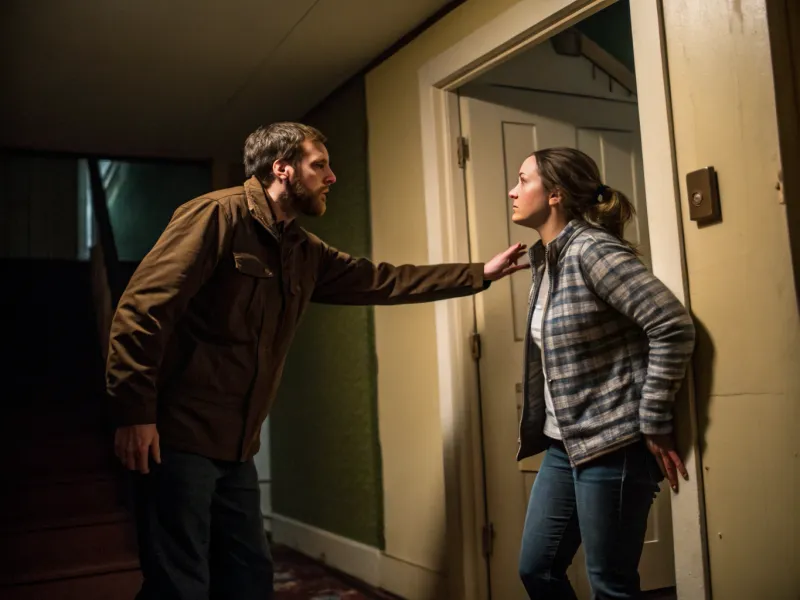29 Ways Unhealed Childhood Trauma Can Affect Your Marriage
Today, I invite you on a journey through a topic that’s both profound and enlightening. Childhood trauma, while often cloaked in silence, has an uncanny way of sneaking into our marriages.
It’s like that unexpected twist in a movie plot—no one really sees it coming, but when it hits, oh boy, does it make an impact! You might wonder how those early experiences shape our adult relationships.
These insights might just give you a new perspective on love and partnership. So, ready to delve into this fascinating world? Here we go!
1. Attachment Style Confusion

Have you ever found yourself wondering why connecting with your partner feels like a complex puzzle? Well, my friend, childhood trauma often influences our attachment styles, turning them into a bit of a mixed bag.
This confusion can make emotional bonding a rollercoaster ride. Imagine trying to cuddle with your partner while your mind races with ‘Do they love me, or are they pulling away?’ These childhood imprints can lead to misunderstandings, where one thinks, ‘I’m being smothered,’ while the other cries, ‘Why are you leaving me?’ It’s a classic case of wires getting crossed.
But don’t worry; acknowledging these patterns is the first step to untangling them. When both partners become aware, it’s like finding the decoder ring to each other’s emotional Morse code. Suddenly, what felt like a mystery now makes a bit more sense.
How liberating is that? So, next time communication hiccups arise, remember it might just be those pesky childhood messages trying to make themselves heard—time to send them packing!
2. Trust Issues

Trust, oh trust! It’s often said that trust is the foundation of any relationship, right? But what happens when childhood experiences throw a wrench in that foundation? If you’ve ever felt like your partner’s loyalty is as slippery as a fish, childhood trauma might be at play.
Those early betrayals or broken promises can shadow our adult trust radar. It’s like having an overactive security alarm, set off by the smallest of things. Maybe a forgotten date or a late call spirals into distrust. But here’s a twist: recognizing the root of these trust hiccups can be freeing. When you start to see these patterns, it’s like finding a frayed wire in a circuit, something you can actually fix.
Conversations become easier, more compassionate, and more understanding. So, next time you feel the trust tremors, breathe, pause, and remember—sometimes, it’s just the echoes of old fears, not the present reality. Building trust anew is not just possible; it’s powerful!
3. Communication Barriers

You know those moments when talking to your spouse feels like you’re both speaking different languages? Yep, that’s a communication barrier, and guess what? Childhood trauma can play a leading role here. Imagine trying to build a bridge with mismatched pieces. Childhood experiences can leave us with unspoken words or, sometimes, too many words!
It’s like having a filter that distorts the message before it leaves your lips. Maybe you learned that speaking up wasn’t safe, or perhaps words were your only shield. These early lessons can make adult conversations tricky, to say the least.
But don’t throw in the towel just yet. Recognizing this pattern is akin to getting the Rosetta Stone for your relationship. Suddenly, those cryptic exchanges start making sense. It’s about finding a new rhythm, where listening and speaking come from a place of understanding rather than defense.
4. Boundary Challenges

Boundaries, boundaries, boundaries! They’re like the invisible fences in relationships, right? But here’s the kicker: childhood trauma can blur these lines, making them feel more like a guessing game. Picture this: one day, you’re too close; the next, you’re too distant. It’s like playing a game of emotional tug-of-war.
These boundary challenges often stem from early environments where ‘no’ wasn’t an option or where privacy wasn’t respected. Fast forward to adult relationships, and setting boundaries feels foreign, almost like learning a new language.
But here’s the silver lining: understanding this pattern is a game changer. It transforms boundaries from barriers into bridges. When you and your partner start seeing these challenges for what they are, suddenly, it’s easier to say, ‘This is what I need,’ without guilt or fear. It becomes a dance of respect and understanding.
5. Emotional Regulation Struggles

Ever feel like your emotions take you on an unpredictable ride, pulling your relationship along with them? Childhood trauma can often be the hidden force behind these turbulent emotional shifts. It’s like having a weather app for your feelings that alternates between sunshine and sudden storms.
These struggles often originate from early experiences where expressing emotions was either discouraged or met with inconsistency. Fast forward to marriage, and managing emotions can feel like navigating rough seas.
But here’s the good news: recognizing this pattern is like finding a personal compass for emotional stability. It’s about developing ways to manage emotions, both individually and as a team.
By identifying each other’s emotional triggers and responses, you foster a space for open and honest communication. When emotional waves crash in, remind yourself: feelings are valid, and with patience and understanding, the storm will pass. Isn’t that reassuring?
6. Fear of Abandonment

That persistent fear of abandonment—it’s like a shadow lurking in the background, isn’t it? If you’ve ever felt a surge of panic when your partner becomes distant, childhood trauma might be fueling that anxiety. This fear often traces back to early experiences of loss or emotional detachment.
Fast forward to the present, and it’s as if an internal alarm system is hypersensitive, interpreting every quiet moment as a potential departure. Thoughts like ‘Are they leaving?’ might echo more often than you’d like. But here’s the silver lining: acknowledging this fear is like switching on a light in a dark room.
Suddenly, the unknown isn’t so daunting. By openly discussing these feelings with your partner, you take away their power. It’s about fostering an environment where reassurance flows naturally, and ‘I’m here’ becomes a comforting promise rather than a question.
7. Perfectionism Pressures

Perfectionism in marriage—it’s like walking a tightrope, isn’t it? If you constantly feel the urge to maintain flawlessness, childhood trauma might be reinforcing that impossible standard. It’s like living with a relentless inner voice insisting that nothing is ever quite good enough.
This pressure often stems from early experiences where love felt contingent on achievements or appearances. Fast forward, and the pursuit of perfection can overshadow genuine connection. But here’s a refreshing thought: recognizing this drive for flawlessness is like finding a hidden key to self-acceptance. It allows you to shift from impossible expectations to celebrating what’s real and meaningful.
By sharing these struggles with your partner, you create an environment of support and understanding rather than judgment. It’s about embracing the beauty of imperfection together.
8. Fear of Intimacy

Intimacy—it’s such a beautifully layered experience, isn’t it? Yet, for some, childhood trauma can turn it into an overwhelming challenge. It’s as if an invisible barrier keeps true emotional closeness just out of reach.
This fear often originates from past betrayals or emotional neglect, embedding the belief that vulnerability equates to danger. Fast forward to marriage, and reaching for deeper connection can feel like stepping toward a ledge.
Acknowledging this fear is like discovering a bridge across that emotional divide. It invites the possibility of closeness in a secure and loving way. By exploring these fears with your partner, you create a space where intimacy is no longer about exposure but about trust and connection.
9. Difficulty with Forgiveness

Forgiveness—it can feel elusive, can’t it? If letting go of past wrongs feels like an uphill battle, childhood trauma might be at the root. It’s like carrying a heavy backpack filled with grievances, making every step forward feel burdened.
These difficulties often stem from environments where forgiveness wasn’t modeled or where holding onto hurt felt safer than releasing it. Fast forward to a marriage, and unresolved emotions can build into an invisible wall. But here’s an empowering shift: recognizing this challenge is like finding a map that leads toward healing.
Forgiveness isn’t about excusing behavior but about freeing yourself from its weight. By fostering empathy and open dialogue, you and your partner can transform past hurts into stepping stones for growth and understanding.
10. Insecurity and Self-Doubt

Insecurity and self-doubt—they have a sneaky way of creeping in, don’t they? If you’ve ever questioned your worth, childhood trauma might be the quiet voice amplifying those doubts. It’s like living with an ever-present critic that second-guesses your every move.
These feelings often stem from early environments where acceptance was overshadowed by criticism or dismissal. Fast forward to marriage, and these insecurities can make even the strongest relationship feel fragile. But here’s a comforting thought: recognizing these emotions is like turning on a flashlight in the dark.
It allows you and your partner to confront self-doubt together, transforming uncertainty into mutual support. By embracing vulnerability and honest communication, you create a relationship where self-doubt loses its hold. Instead of whispers of insecurity, you build a foundation of affirmation and confidence.
11. Control Issues

Control—it can feel like a safeguard, can’t it? If you often feel the need to manage every aspect of your relationship, childhood trauma might be the driving force behind that urge. It’s like having an internal GPS that insists on dictating every turn.
This need for control often develops in unpredictable early environments where stability felt out of reach. Fast forward to marriage, and this manifests as a tug-of-war for dominance, creating tension and misunderstandings.
Recognizing this tendency is like loosening a tight grip on the reins. It’s about learning to trust in the natural flow of your partnership rather than trying to orchestrate every detail. By opening up to your partner, you invite collaboration and shared decision-making rather than resistance.
12. Overreacting to Conflict

Conflict—it’s an unavoidable part of any relationship, yet for some, even minor disagreements trigger overwhelming responses. If a small dispute feels like an impending disaster, childhood trauma might be amplifying those reactions. It’s as if your emotional alarm system is stuck on high alert, interpreting every disagreement as a major threat.
This tendency often originates from past environments where conflicts were either explosive or completely avoided, leaving no healthy resolution model. Fast forward to marriage, and even minor disagreements can escalate into emotional turmoil.
Learning to approach conflict with a sense of curiosity rather than fear can change everything. By openly discussing these triggers with your partner, you create a space where conflicts become opportunities for understanding rather than battles to endure.
13. People-Pleasing Tendencies

People-pleasing—it often disguises itself as kindness, but deep down, it can be exhausting, can’t it? If you find yourself constantly prioritizing your partner’s needs at your own expense, childhood trauma might be reinforcing this habit. It’s like wearing a mask that smiles through discomfort, striving to maintain harmony.
This tendency often develops in early environments where love and approval were tied to self-sacrifice. Fast forward to marriage, and this pattern can lead to feelings of invisibility or neglecting your own needs.
Balancing care for others with self-care is key. By discussing these tendencies with your partner, you foster a relationship that values mutual respect, where both partners’ needs are acknowledged and met. Love should be about reciprocity, not relentless giving.
14. Emotional Detachment

Ever felt emotionally distant from your partner at crucial moments? Childhood trauma might be the silent force shaping this disconnect. It’s like living with a dimmer switch on emotions, never quite letting them shine at full brightness.
This pattern often originates in early environments where expressing feelings was met with indifference or disapproval. Over time, this learned detachment carries into marriage, making intimacy feel like a bridge that never fully reaches the other side.
By embracing vulnerability, you create a sanctuary where emotions can be safely exchanged. Together, you can transform barriers into pathways toward deeper connection.
15. Hyper-Vigilance

Hyper-vigilance—it’s like having an ever-active radar scanning for danger. If you find yourself constantly on edge in your relationship, past trauma might be programming this alert system. It’s as if an internal security force is always bracing for the worst.
This heightened state of awareness often develops in unpredictable or high-stress childhood environments. As an adult, it can lead to a relationship dynamic where true peace feels fleeting, as though calmness is just a pause before the next crisis. Learning to trust in the stability of your partnership allows you to let go of unnecessary alerts and embrace moments of serenity.
By voicing these fears with your partner, you foster an atmosphere where trust and ease become the foundation, rather than the exception.
16. Overdependence

Overdependence—it’s like walking a tightrope, always seeking balance but fearing the fall. If leaning too much on your partner feels like second nature, unresolved childhood trauma might be scripting this dynamic. It’s as if your partner becomes the sole source of stability, the anchor in every storm.
This deep reliance often stems from an upbringing where security was uncertain, making attachment feel like a survival instinct. In marriage, this can lead to a loss of individuality, with reassurance overshadowing self-sufficiency. But recognizing this pattern is the first step toward independence. Think of it as shifting from a tightrope to a steady bridge—one that allows both support and personal growth.
By fostering open dialogue, you create a relationship where connection and autonomy coexist harmoniously. The next time the impulse to over-rely arises, remind yourself: love thrives on partnership, not possession.
17. Fear of Conflict

If you go to great lengths to avoid disagreements, childhood experiences might be reinforcing the idea that conflict equals chaos. It’s as if even minor tensions feel like brewing storms.
This avoidance often originates in environments where conflict was either destructive or met with silence, making any disagreement feel unsafe. In marriage, this can result in important concerns being left unspoken, creating an undercurrent of unresolved tension. But confronting this fear is like opening an umbrella in a storm—you gain control instead of being swept away.
By cultivating open conversations, you and your partner create a space where disagreements lead to resolution rather than division. Love isn’t about sidestepping issues; it’s about navigating them together.
18. Low Self-Esteem

Low self-esteem—it’s like a shadow that follows, constantly whispering doubts. If you’ve ever felt undeserving of love, past wounds might be shaping this belief. It’s as if a critical inner voice is always questioning your worth.
This struggle often takes root in childhood, where validation was inconsistent or conditional. In a relationship, it can manifest as insecurity, making it difficult to fully accept affection or trust in your own value. But recognizing this pattern is like switching on a light—the shadow loses its power.
By nurturing self-compassion and openly communicating with your partner, you create a relationship where both of you feel valued and appreciated. Love flourishes where acceptance, not self-doubt, takes center stage.
19. Fear of Being Unlovable

If you’ve ever questioned whether you are truly worthy of deep connection, childhood trauma might be fueling this fear.
This belief often stems from early experiences where affection felt inconsistent or had to be earned. In a marriage, it can create a barrier that keeps you from fully embracing love. But acknowledging this fear is like applying a soothing balm—it helps heal the wounds of doubt.
Learning to accept love as constant rather than fleeting transforms relationships into spaces of security. With open conversations and self-acceptance, you and your partner can nurture a connection that reinforces love’s permanence.
20. Passive-Aggressive Behavior

Passive-aggressive behavior—it’s like speaking in riddles, hoping someone else will decipher them. If indirect expressions of frustration feel safer than honesty, childhood trauma may have shaped this habit. It’s as if direct communication carries too much risk, so subtle digs and avoidance take its place.
This pattern often originates in environments where expressing needs led to conflict or dismissal. In a marriage, it can turn communication into a guessing game, making resolution difficult. But acknowledging this tendency is like finding a lost key—it opens the door to clarity.
By choosing openness over ambiguity, you create a relationship where transparency replaces misinterpretation. Love grows in spaces where understanding is prioritized over silent battles.
21. Feelings of Guilt and Shame

The guilt and shame often root back to early environments where mistakes were magnified and compassion was scarce. Fast forward to marriage, and this can create a dynamic where these feelings overshadow moments of joy and connection.
But here’s a hopeful thought: recognizing these feelings is like finding a ray of light through the clouds. It’s about learning to forgive yourself and embrace the love and compassion offered by your partner. By fostering open communication and self-compassion, you create a relationship that nurtures healing and growth.
So, the next time guilt and shame surface, pause and remind yourself: love is about understanding, not condemnation. Isn’t that an encouraging perspective? Together, you can cultivate a loving environment where forgiveness and acceptance thrive.
22. Neglecting Personal Needs

Constantly prioritizing your partner’s needs over your own can feel like running a marathon on empty. If self-care seems indulgent or unimportant, past experiences may have shaped this belief. Growing up in an environment where personal well-being was overlooked or deemed selfish often leads to self-neglect in adulthood.
In a marriage, this tendency can result in exhaustion and quiet resentment. However, recognizing the importance of balance is like learning to refill your own cup—it allows you to give from a place of fulfillment, not depletion.
Open conversations about boundaries and self-care cultivate a relationship where both partners feel valued. Love flourishes when personal well-being is embraced, not sacrificed.
23. Difficulty Setting Goals

Drifting through life without clear goals can feel like navigating without a map. If long-term aspirations seem out of reach, early experiences may have instilled self-doubt. Growing up in an environment where dreams were dismissed or failure was magnified often makes ambition feel risky.
Within a marriage, this uncertainty can create a sense of stagnation, making it difficult to plan for the future. Yet, shifting this mindset is like discovering a compass—direction becomes clearer with each step forward.
Encouraging open discussions about aspirations and setting small, achievable milestones together fosters a relationship where growth is embraced. Love thrives when both partners feel supported in pursuing their individual and shared dreams.
24. Fear of Change

Standing at the threshold of change can feel unsettling as if stability is slipping away. If the idea of transition sparks anxiety, past experiences with unpredictability might be influencing this fear. Growing up in an environment where change brought distress rather than opportunity often leads to a desire for a strict routine.
In marriage, resistance to change can stifle growth, making it difficult to embrace new chapters together. Yet, reframing change as a doorway to new possibilities allows for a healthier perspective.
Leaning on your partner for reassurance and facing transitions as a team fosters resilience. A strong relationship isn’t defined by staying the same—it’s built on evolving together.
25. Struggles with Independence

Finding the balance between autonomy and connection can feel like a tightrope walk. If embracing independence seems unsettling, childhood influences may have blurred the line between self-sufficiency and detachment. Growing up in an environment where autonomy was discouraged or met with rejection often creates a fear of standing alone.
Within a marriage, this struggle can manifest as hesitation in making decisions independently or an overreliance on a partner for validation. Recognizing this pattern is like stepping onto solid ground—realizing that independence and love can coexist.
Encouraging personal growth while maintaining a strong bond strengthens the relationship. A thriving partnership is built on trust, where both individuals feel empowered to explore their own paths while staying connected.
26. Resentment Build-Up

Bottling up frustrations can feel like carrying a weight that only gets heavier over time. If unspoken grievances linger beneath the surface, childhood experiences may have shaped an avoidance of conflict. Growing up in an environment where emotions were ignored or dismissed often leads to suppressing feelings rather than addressing them.
In marriage, unresolved resentment can quietly erode intimacy, creating emotional distance. Acknowledging these emotions is like opening a pressure valve—releasing tension before it overflows.
Creating a habit of honest and compassionate communication ensures both partners feel heard. Love deepens when emotions are expressed openly, rather than left to simmer in silence.
27. Need for Constant Reassurance

Seeking validation in a relationship can feel like grasping for an anchor in shifting waters. If the need for frequent reassurance feels overwhelming, early experiences may have instilled uncertainty about love’s permanence. Growing up in an environment where affection was inconsistent or conditional often fosters a lingering fear of abandonment.
Within marriage, this reliance on external validation can create an emotional imbalance, leaving one partner feeling exhausted and the other perpetually unsure. Yet, cultivating self-trust is like learning to sail with confidence—embracing love’s constancy without needing constant proof.
Open communication and practicing self-assurance allow a relationship to feel secure. Love isn’t about continuous reassurance; it’s about trust in the foundation you’ve built together.
28. Comparing Your Relationship to Others

If you often find yourself measuring your marriage against someone else’s, there might be more to it than just curiosity. Childhood trauma can instill a deep sense of inadequacy, making it easy to believe that everyone else has it better. It’s like watching everyone’s highlight reel while battling your own behind-the-scenes chaos.
This comparison trap usually stems from early messages that told us we weren’t enough—so naturally, we seek validation externally. In marriage, this can breed resentment or insecurity, as we chase an ideal that might not even exist.
But here’s the shift: when you recognize that those comparisons are echoes of old wounds, you can start focusing inward. Every couple is unique. When you stop holding your relationship to someone else’s standard, you create space to nurture something real, imperfect, and beautiful.
29. Avoiding Vulnerability

Being vulnerable in marriage can feel terrifying when your past has taught you that opening up leads to hurt. If you find yourself keeping emotions at arm’s length, childhood trauma might be guarding the door. Vulnerability can feel like a risk you can’t afford to take.
In early environments where vulnerability was punished or ignored, building walls becomes second nature. Fast forward to marriage, and those walls can block intimacy, making your partner feel distant even when you’re right next to them.
But here’s the truth: vulnerability is where real connection lives. Letting your guard down, even a little, can be transformative. It’s not about being unbreakable—it’s about trusting that your partner will hold your heart gently. Love can’t thrive in hiding, but it flourishes in authenticity.







